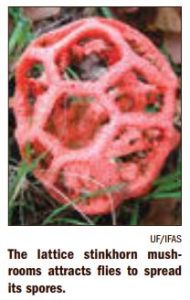Most people are familiar with the group of organisms called fungi, owing to the mushrooms that you can find in grocery stores. In addition to being a delicious ingredient used in many culinary creations, fungi play a very important role in the ecosystem. This week we will dive under the leaf litter to learn about fungi and the role they play in the environment. Did you know the mushrooms you add to your salad are the fruiting body of a fungus? The main, larger part of the fungus, called the mycelium, grows hidden underground. The mycelium consists Fungi play important role in ecosystem of threadlike tendrils that wind through the soil seeking plant or animal material to decompose. The mycelium can grow to huge proportions, often covering several acres of area. After heavy rains, you may notice an explosion of mushrooms overnight. Fungi’s fruiting bodies can vary in size, colors and shapes. Mycologists, or mushroom scientists, use the fruiting bodies to identify different species. The main way fungi reproduce is by spores. When conditions are right, the fungus sends up mushrooms to facilitate the spread of these spores. The spores are often located on the underside of the mushroom cap, inside gills or pores.
The mycelium consists Fungi play important role in ecosystem of threadlike tendrils that wind through the soil seeking plant or animal material to decompose. The mycelium can grow to huge proportions, often covering several acres of area. After heavy rains, you may notice an explosion of mushrooms overnight. Fungi’s fruiting bodies can vary in size, colors and shapes. Mycologists, or mushroom scientists, use the fruiting bodies to identify different species. The main way fungi reproduce is by spores. When conditions are right, the fungus sends up mushrooms to facilitate the spread of these spores. The spores are often located on the underside of the mushroom cap, inside gills or pores.
 One interesting-looking fungus to search for in the Florida Keys is the lattice stinkhorn mushroom. This mushroom does not look like a typical mushroom with a stalk and cap. When first emerging from the ground, the lattice stinkhorn looks like a little white golf ball. A day later, it turns red and expands to the size of a grapefruit, with a beautiful lattice structure. It’s called the stinkhorn, because, frankly, it stinks. While some mushrooms rely on the wind to spread their spores, the stinkhorn mushroom has another method. It attracts insects by emitting a stench, and the visiting insects get covered in spores as they move around the lattice shape. When the bugs travel on, the spores still on their bodies can spread to other locations. Fungi are decomposers and play a vital role in breaking down wood, plant and animal remains. As the plant and animals decompose, they are recycled into the nutrients that plants and trees need to grow.
One interesting-looking fungus to search for in the Florida Keys is the lattice stinkhorn mushroom. This mushroom does not look like a typical mushroom with a stalk and cap. When first emerging from the ground, the lattice stinkhorn looks like a little white golf ball. A day later, it turns red and expands to the size of a grapefruit, with a beautiful lattice structure. It’s called the stinkhorn, because, frankly, it stinks. While some mushrooms rely on the wind to spread their spores, the stinkhorn mushroom has another method. It attracts insects by emitting a stench, and the visiting insects get covered in spores as they move around the lattice shape. When the bugs travel on, the spores still on their bodies can spread to other locations. Fungi are decomposers and play a vital role in breaking down wood, plant and animal remains. As the plant and animals decompose, they are recycled into the nutrients that plants and trees need to grow.
Recently, scientists have found that fungi play another important role in the forest. As the mycelium spreads throughout the forest floor, the threads grow around, and form close associations with, the roots of living trees and plants. These associations, called mycorrhizal associations, are mutualistic, a type of symbiotic relationship where both organisms benefit. The plants and trees provide the fungi with food in the form of carbohydrates. In exchange, the fungi help the plants and trees suck up water, and provide nutrients like phosphorus and nitrogen via their mycelia. There is now evidence that plants can even communicate and share nutrients with each other using the mycorrhizal fungal network. Next time it rains, head outside and see how many different species of fungi you can find. A great place to start is at your local Florida State Park. Visit floridastatepark.org to plan your next adventure.
Becky Collins is a park service specialist with the Florida Keys Overseas Heritage Trail.

Are there times of the year mushrooms are more prevalent in the Florida Keys? What are some of the other species found in the Keys, and are any of them mycorrhizal?